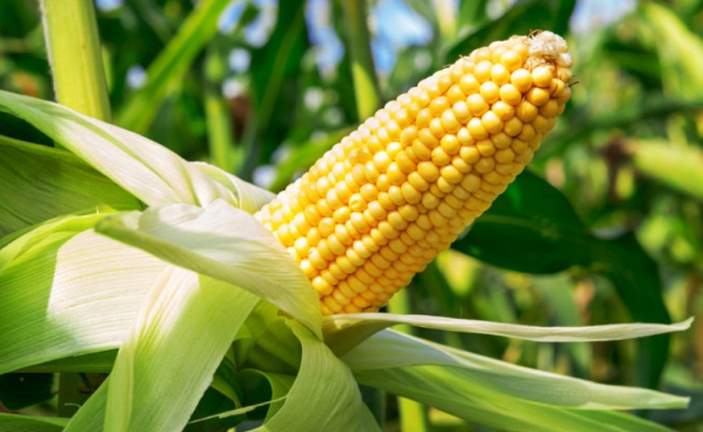Corn, maize, or Zea mays is a cereal grain, botanically considered as a fruit that is a staple food in several places in the world. Besides direct consumption by humans as cornmeal or masa, it is an animal feed. Also, it has many products like corn syrup and starch as well as in alcoholic beverage manufacture, corn oil production, among other uses.
The most common types of maize include the flint, dent, pod, flour, sweet corn (sugar-rich) as well as popcorn. Can bunnies eat corn, including corn kernels (fresh, dried or cracked), husks, corncobs, corn on the cob, the maize plant?

Can rabbits eat corn?
No. Rabbits shouldn’t eat corn or corn kernels (fresh, dried, cracked) or popcorn. They are unhealthy and present a health risk. Some of the reasons why these animals shouldn’t eat them include the following:
1. Have indigestible hulls
Corn kernels have indigestible hulls that may cause intestinal blockages or impactions that are life-threatening. Unlike pectin and cellulose that form plant cell walls, these hulls have a complex polysaccharide that bunny’s digestive system cannot digest.
2. High in carbohydrates
Secondly, for instance, if you consider sweetcorn. Looking at its nutritional composition, it does have protein and most of the essential amino acids in small quantities.
It also has thiamine, riboflavin, pantothenic acid, vitamin B6, folate, vitamin C, iron, magnesium, manganese, phosphorus, zinc, and potassium. They all look good. Rabbits need them.
However, it has about 18.7g of carbohydrates per 100g or 18.7%. Such levels of carbs will overload their hindgut fermentation chamber (cecum) and potentially cause enteritis, stomach upsets, diarrhea, and so on.
Also, excessive carbs inhibit motilin release, which promotes GI movement. Without motilin, we are looking at GI stasis.
Finally, looking at the calories that corn has, your rabbit will go obese if it doesn’t suffer from gastrointestinal blockages.
3. Low in fiber
Perfect rabbit diet needs to be high in fiber about 18-25% with lactating, growing or nursing bunnies requiring slightly a lower amount. However, maize don’t have much fiber, which supports a healthy gut, keeps things flowing and helps wear down their ever-growing teeth.
4. Risk of contamination with mycotoxins
It is not uncommon to find maize contaminated with mycotoxins like zearalenone, aflatoxins, trichothecenes, or fumonisins, which will hurt your rabbit’s health, other animals, or even yourself.
Can rabbits eat corncob?
Rabbits shouldn’t eat corncobs, whether fresh or dried ones. Like hulls, they present a risk of impaction. Also, they are not easy to chew, and your bunny will have to work extra hard to eat them, especially if they are fully mature and dry.
Instead, they have other applications including fodder to ruminants (bunnies are hindgut fermenters), making furfural industrially, biofuel, charcoal production, among other uses.
Finally, they have little nutritional value, another reason why you shouldn’t give them to your furry friends.
Baby sweetcorn and corn on the cob
Also known as cornlets, they maize on corn cob harvested before maturity and eaten entirely with the cob as a vegetable, raw or cooked, especially stir-fried with other foods.
While they present a slightly lower risk of impaction, like mature maize, they are unhealthy to your rabbits, i.e., they are starchy, high in sugars, and high in calories.
Corn husks
They are the leafy outer other coverings of maize that offers protection. Rabbits can eat fresh, green corn husk as a treat. They will enjoy chewing them, and you can use them to make a simple homemade chew toy.
Don’t worry about them being stringing. The rabbit’s chisel-like incisors will be able to cut them before they can grind them using their premolars and molars.
However, ensure you go for organic ones since they are not treated with any harmful fertilizers, pesticides, or herbicides that may harm your furry friend.
Can rabbits eat maize leaves and stalks?
Yes. Bunnies can eat corn leaves and stalks. Even while in the wild, they will enjoy eating young maize plants. However, after the maize has matured and as they are ripe, they have little or no nutritional value.
You can make the soft, green leaves a part of the leafy greens they eat while for the stalks, give them as a treat.
However, avoid them if they are treated with pesticides, herbicides, or harmful fertilizers. It makes them potentially dangerous to your furry critter. Also, avoid the moldy ones.
No to popcorns
Like maize kernels, rabbits shouldn’t eat popcorns as they are starchy, have indigestible hulls, and may have added salt and fats. Salty snacks are unhealthy for your furry friend.
Desist from giving them some as they will enjoy eating them and may beg for more. However, these popped maize kernels are unsafe, like maize kernels.
Proper diet matters
For optimum health and longevity, rabbits require the right diet, which should have the following components:
- Grassy hay – It should account for not less than 80% of their diet. Hay is high in fiber and better nutritionally balanced. It will help wear their teeth, promote a healthy gut, and promote a smooth flow of food in their gastrointestinal tract.
- Greens or fresh foods – They should account for 10-15% of what your bunny eats with leafy greens accounting for the bulk part. The rest of the fresh foods like herbs, flowers, fruits, and non-leafy veggies are treats.
- Pellets – High fiber pellets are fortified with minerals to ensure your bunny gets all the nutrients they require. However, bunnies need only a small amount of pellets, about 5% of their diet.
- Treats – They include the fresh foods we have mentioned as well as commercial ones. Keep the total amount they eat at 0-5% of their calorific intake.
Conclusion
Rabbits shouldn’t eat fresh or dry maize kernel, cobs, sweetcorn, or maize on the cobs as they are unhealthy and present other health risks. However, they can eat maize leaves as a part of their leafy greens and maize stalks as a chew treat.
